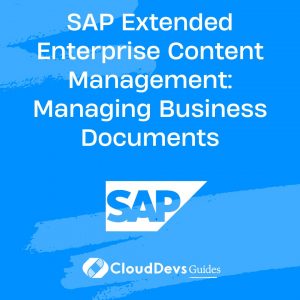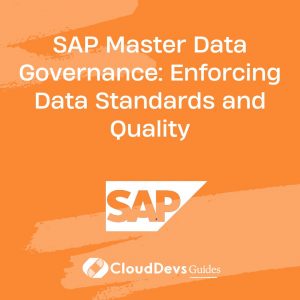SAP Supply Chain Management: Improving Efficiency and Visibility
In the ever-evolving landscape of modern business, supply chain management has become a pivotal aspect of success. Companies are constantly seeking ways to optimize their supply chains, reduce costs, and enhance visibility into their operations. One powerful solution that has been driving these improvements is SAP Supply Chain Management (SAP SCM).
SAP SCM is a comprehensive suite of applications and tools designed to streamline and optimize every aspect of the supply chain. In this blog post, we will explore how SAP SCM can significantly improve efficiency and visibility within your organization. We’ll delve into key features, benefits, and provide real-world code samples to demonstrate its capabilities.
1. Understanding the Importance of Supply Chain Management
Before we dive into the specifics of SAP SCM, it’s crucial to grasp why supply chain management is so critical in today’s business environment.
1.1. The Role of Supply Chain Management
Supply chain management encompasses the planning, execution, monitoring, and control of all supply chain activities. This includes procurement, production, distribution, and logistics. An efficient supply chain not only reduces operational costs but also enhances customer satisfaction and competitiveness.
1.2. Challenges in Supply Chain Management
Modern supply chains face various challenges, including:
- Globalization: Expanding into global markets brings complexity in managing suppliers, transportation, and compliance.
- Demand Variability: Fluctuating customer demands require agile responses to avoid overstocking or stockouts.
- Complexity: Supply chains involve numerous stakeholders, each with their own processes and systems.
- Visibility: Inadequate visibility into supply chain activities can lead to inefficiencies and disruptions.
SAP SCM is designed to address these challenges head-on and provide a holistic solution for efficient and visible supply chain operations.
2. Key Features of SAP Supply Chain Management
SAP SCM offers a wide array of features and capabilities that empower organizations to streamline their supply chain processes and enhance visibility. Let’s explore some of the most prominent features:
2.1. Advanced Planning and Scheduling (APS)
Advanced Planning and Scheduling is a crucial component of SAP SCM. It enables organizations to optimize production and distribution plans, ensuring the right products are produced at the right time while minimizing inventory costs. Here’s a code sample demonstrating how APS can be utilized:
python # Sample APS code import sapscm aps = sapscm.AdvancedPlanningScheduler() aps.load_data() aps.optimize_schedule()
2.2. Real-time Analytics
SAP SCM provides real-time analytics and reporting capabilities, allowing organizations to monitor their supply chain activities as they happen. This empowers businesses to make data-driven decisions swiftly. Below is an example of generating a real-time supply chain dashboard:
javascript // Sample JavaScript code for generating a supply chain dashboard const dashboard = new SAPSCMRealTimeDashboard(); dashboard.load_data(); dashboard.generate_dashboard();
2.3. Demand Forecasting
Accurate demand forecasting is essential for efficient supply chain management. SAP SCM incorporates advanced algorithms and machine learning to predict demand accurately. Here’s a code snippet showcasing demand forecasting:
R # Sample R code for demand forecasting library(SAPSCM) demand_forecaster <- create_demand_forecaster() demand_forecaster.train(data) forecasted_demand <- demand_forecaster.forecast()
2.4. Supplier Relationship Management (SRM)
Managing supplier relationships is simplified with SAP SCM’s Supplier Relationship Management module. It enables organizations to collaborate seamlessly with suppliers, track performance, and ensure timely deliveries. Here’s an example of how SRM can be implemented:
java // Sample Java code for Supplier Relationship Management import com.sap.scm.SupplierRelationshipManager; SupplierRelationshipManager srm = new SupplierRelationshipManager(); srm.connect_to_suppliers(); srm.track_performance();
3. Benefits of Implementing SAP Supply Chain Management
Implementing SAP SCM offers numerous benefits, including:
3.1. Cost Reduction
Efficient supply chain processes lead to reduced operational costs, including inventory holding costs and transportation expenses.
3.2. Improved Customer Satisfaction
Meeting customer demands promptly and accurately enhances customer satisfaction and loyalty.
3.3. Enhanced Visibility
SAP SCM provides end-to-end visibility into supply chain activities, reducing the risk of disruptions and enabling proactive issue resolution.
3.4. Agility and Responsiveness
With real-time analytics and demand forecasting, organizations can respond swiftly to changing market conditions and customer demands.
3.5. Collaboration
SAP SCM fosters collaboration with suppliers, ensuring a reliable and responsive supply chain network.
4. Real-world Case Study: SAP SCM in Action
To better understand how SAP SCM can transform supply chain operations, let’s take a look at a real-world case study.
Case Study: XYZ Corporation
Challenge: XYZ Corporation, a global manufacturing company, faced challenges in optimizing its complex supply chain, resulting in high inventory costs and delays in order fulfillment.
- Solution: XYZ Corporation implemented SAP SCM to streamline its supply chain processes. Advanced Planning and Scheduling (APS) helped optimize production plans, reducing excess inventory. Real-time analytics improved visibility, enabling proactive issue resolution.
- Results: Within six months of implementing SAP SCM, XYZ Corporation reduced inventory costs by 20% and improved order fulfillment times by 30%. Customer satisfaction increased significantly.
5. Getting Started with SAP SCM
If you’re considering implementing SAP SCM in your organization, here are the initial steps to get started:
5.1. Assess Your Needs
Identify the specific challenges and goals of your supply chain operations. This will help you determine which SAP SCM modules and features are most suitable for your organization.
5.2. Engage SAP Experts
Collaborate with SAP experts or consultants who can guide you through the implementation process, ensuring that you make the most of SAP SCM’s capabilities.
5.3. Training and Integration
Provide training to your team members on how to use SAP SCM effectively. Additionally, ensure seamless integration with your existing systems and processes.
5.4. Continuous Improvement
Regularly review and optimize your supply chain processes using SAP SCM to stay competitive and responsive to market changes.
Conclusion
In today’s highly competitive business environment, efficient supply chain management is essential for success. SAP Supply Chain Management offers a robust solution to enhance efficiency and visibility in your supply chain operations. By leveraging its advanced features, such as APS, real-time analytics, demand forecasting, and SRM, organizations can reduce costs, improve customer satisfaction, and stay agile in a rapidly changing market.
Don’t wait—start exploring SAP SCM today and transform your supply chain into a strategic advantage.
Table of Contents









